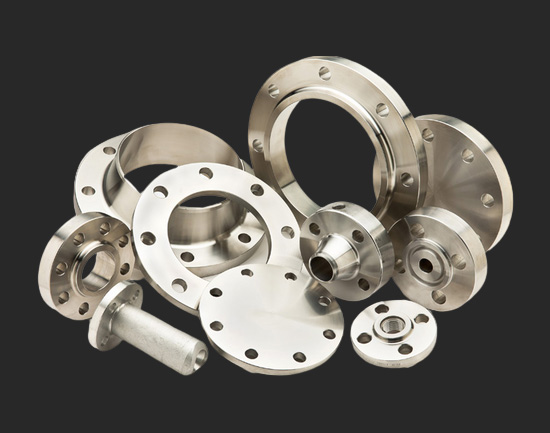Explore the fundamentals of flanges with our in-depth guide. Discover flange functions and types, as well as their importance in a range of industries.
Things to learn before taking into account when selecting a flanges for your piping system
What is Flanges?
Flanges are a projecting flat rim, collar, or rib on an object, serving for strengthening or attachment or (on a wheel) for maintaining position on a rail.
What is the purpose of Flanges?
A flange is a device used to join pipes, valves, pumps, and other pieces of machinery to create a piping system. Additionally, it offers simple access for maintenance, review, or modification. Flanges are typically welded or screwed. Flanged joints are created by bolting together two flanges with a gasket in between them to act as a seal.
How are flanges manufactured?
The following steps are included in the flange manufacturing process:
- Raw materials: After being inspected for quality and flaws, the materials are machined to the required tolerances. Materials are formed into flanges using a variety of techniques, including casting, forging, cutting, and rolling.
- Testing: The flanges’ mechanical characteristics, dimensions, and surface quality are all examined.
- Finishing: The flanges are customized and sealed by the relevant standards. The manufacturer’s name, size, material grade, and other details are marked on the flanges. The flanges are packaged and delivered to the customers during dispatch.
What are different Types of flanges?
The following steps are included in the flange manufacturing process:
- 1. WELDNECK Flange – A Weldneck flange has a long hub with a tapered transition to the pipe or fitting to which it is welded. Typically, it is butt-welded to the line, meaning that the end is inserted into the flange and then welded circumferentially. This produces a strong and watertight joint. The hub reinforces the flange as well.
- 2. SLIPON Flange – Slip-on (SO) flanges have a flat face on the sealing surface and are commonly used in low-pressure applications. They are referred to as “slip-on” because they can be slipped onto the end of a pipe or fitting and then welded into place. Additionally, they have a bored-out inner diameter that corresponds to the outer diameter of the pipe, which facilitates the smooth flow of fluids or gases.
- 3. BLIND Flange – A blind flange (also known as a ‘closure plate flange’) is used to terminate the pipe at the final point of a piping system. The lack of a central hole (bore) prevents any flow through the flange. A pipe, valve, or pressure vessel may be isolated using a blind flange. This type of flange is available in all sizes and classes, and its joint face may be flat, raised, or ring-shaped.
- 4. ORIFICE Flange – Orifice flange are specialized types of flanges used in piping systems and industrial applications to facilitate the measurement and control of fluid flow. These flanges are designed to accommodate the installation of an orifice plate, which is a device used to measure the rate of fluid flow through a pipeline.
- 5. SPECTACLE BLIND Flange – Spectacle Blinds are simple safety devices that are installed between two pipe flanges. During normal operation, the open end is installed as a spacer to allow uninterrupted flow. To stop the flow in the pipeline, the blind end is rotated into place between the flanges.
- 6. LONG WELDNECK Flange – A Long Weld Neck Flange is a self-reinforcing integral Flange connection utilized primarily for ASME Pressure Vessel applications. The Long Weld Neck (LWN) Flange was designed to be used in place of a Weld Neck Flange and pipe for a bolted connection to the vessel
- 7. Spacer & Paddle Flange –
- a. Spacer flanges are utilized to create a gap between two other flanges in a pipeline. They serve a variety of functions, including isolating sections of the pipeline, permitting maintenance on a specific section without shutting down the entire pipeline, and accommodating the installation of specific equipment.
- b. Paddle Flanges – Paddle flanges, also known as Padder flanges, are designed to extend the length of a flanged connection. These flanges add extra length to a pipeline connection, which can be useful when there’s a need for additional space or to accommodate the fitting of extra components or equipment
- 8. SCREWED/THREADED Flange – Screwed or threaded flanges, also known as threaded pipe flanges, are types of pipe flange used to connect pipes, valves, or other equipment with threaded ends in piping systems. Internal threads on these flanges allow them to be screwed onto the external threads of pipes or other fittings. In situations where welding is undesirable or impractical, screwed flanges are commonly used.
- 9. SPECTACLE Flange – A spectacle flange is a specialty flange made of two metal discs attached in the middle by a small section of steel. Spectacle flanges get their name because they look like a pair of reading glasses, or spectacles.
- 10. NIPO/WELDO Flange – NIPO/WELDO Flange, also known as Nipolet or Weldolet flanges, are specialized types of flanges used in piping systems for specific purposes . It combines nipolet, weldolet, and welding neck flange. These mostly have 90° branch connections. Nipolet and weldolet are not welded together. Most industries prefer Weldo/Nipo Flanges because they hold pressure.
- 11. REDUCING Flange – Reducing flange, also known as reducer flanges or reducing weld neck flanges, are a type of pipe flange used in piping systems to connect pipes of different diameters. These flanges have one end with a larger bore size (inner diameter) and another end with a smaller bore size, effectively reducing the pipe size at the connection point. Here’s a description of reducing flanges:
- 12. LAPPED JOINT Flange – A lap-joint flange is a two-component assembly, with a stub end that has a lap-joint ring flange placed over it. The stub end is then butt welded to the pipe, and the flange ring can be rotated to align with the mating flange
- 13. Socketweld Flange – Socket-weld pipe flange are typically useful on smaller sizes of high-pressure pipes. These pipe flanges are attached by inserting the pipe into the socket end and applying a fillet weld around the top. It allows for a smooth bore and better flow of the gas or fluid inside the pipe.
In conclusion, selecting the right flange is a critical decision that significantly impacts the performance, integrity, and safety of a piping system. The choice of flange type and specifications should align precisely with the unique requirements and demands of the specific system in question. Factors such as pressure, temperature, fluid type, and operational conditions all play pivotal roles in determining the most suitable flange for the application.
Nexus Alloys and Steels is a trusted leader in manufacturing and exporting diverse, high-quality flanges. Committed to excellence, precision, and meeting international standards, we’re your preferred choice for flange solutions.
Experience top-notch quality and unmatched service with Nexus Alloys and Steels; Contact us today to elevate your piping system with our high-quality flanges!

